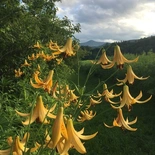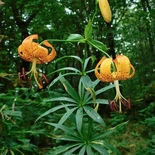Adding insult to injury
“The native American beauties that turned rural roads into blazes of color in the days when America was naturally beautiful!” Wouldn’t you know that people – even this nursery – often call this invasive plant a “native”? As galling as it may be, it’s understandable. All our lives, we’ve seen this plant growing in so many places – in ditches, along roadsides, in grandma’s garden – it seems like it belongs here. But it doesn’t.
This “native” is not a native here
This Asian native was introduced to our continent by way of Europe in the late nineteenth century. It’s often referred to as the “native daylily” (or sometimes orange, tawny, or common daylily – even ditch or outhouse daylily because of its popular locations), but its botanical name is Hemerocallis fulva. A related invasive daylily, known as lemon daylily (H. flava), isn’t distributed as widely.

Orange Daylily(Hemerocallis fulva)
Daylilies spread primarily by thick, tuberous roots that rapidly become large, dense clumps. The infestations of daylilies seen in meadows, floodplains, moist woods, and forest edges are often the long-living remnants of plantings from old home sites, or have escaped from adjacent home landscapes.
They’re beautiful, so what’s wrong?
And as with many invasive plants, the reasons they’re problematic ecologically are often the very reasons they’re popular. “They are self-multiplying, and are a fast spreader,” says one advertisement. Another touts them as maintenance-free since “the mat of roots and the heavy shade of the dense foliage prevent other species from invading the colony.” Another company displays a photograph demonstrating that impenetrable mats of these daylilies can grow even in a heavily shaded woodland. Precisely.
An Internet discussion about H. fulva illustrates some common misconceptions about invasive plants. One comment was that they would plant this daylily (and other non-natives) anyway since “how many of us humans are native to the areas we call home?” But people are not the same as plants, especially with respect to their role in ecosystems.
Another comment was in response to a question about removing a troublesome patch of daylilies in a home landscape. The answer given was that they “belong away from the garden, better for along the road.” It illustrates the common misconception that invasive plants are only a problem when they disrupt home landscapes, and what happens in natural areas is inconsequential.
Easy to sprout, but not so easy to get rid of
It’s not an easy job, but when you do remove daylilies, make sure you get every bit of the tuber, since it can resprout. And don’t throw away whole plants since they might take hold wherever they land. They do seem to compost nicely, though.
What about the many, many daylily cultivars? True, they don’t spread aggressively by rhizomes as does H. fulva, but they do form large, dense clumps. Even more importantly – invasive or not – non-native plants such as these don’t participate in the ecosystem, providing food for insects and other wildlife, as do native plants.
Excellent alternatives

Smooth Oxeye(Heliopsis helianthoides)

Canada Lily(Lilium canadense)

Wood Lily(Lilium philadelphicum)

Turk's-Cap Lily(Lilium superbum)

Browneyed Susan(Rudbeckia triloba)
Rather than hybrid daylilies, many beautiful native plants are good alternatives to the ditch daylily. Try ox-eye sunflower (Heliopsis helianthoides), Canada lily (Lilium canadense), wood lily (Lilium philadelphicum), Turk’s cap lily (Lilium superbum), and three-lobed coneflower (Rudbeckia triloba). These true native-American beauties will turn your yard into blazes of color and make America naturally beautiful.

